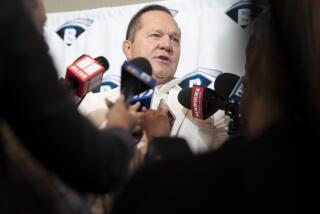Lockout Ends; Season to Start April 9 : Baseball: Openers are delayed for one week after a four-year agreement is reached. Negotiations began Nov. 28.
- Share via
A settlement was reached in baseball’s collective bargaining talks Sunday night, ending the owners’ spring training lockout after 32 days.
As part of the four-year agreement, players have been guaranteed three weeks of training camp--meaning that all or part of the first week of the regular season, scheduled to start April 2, may have to be canceled.
Commissioner Fay Vincent, attending a news conference that began in New York at 1:15 EST this morning, said the camps will open Tuesday, providing the new agreement has been signed by then.
The first exhibition games will be played March 26, he said, with the season scheduled to begin April 9.
The season, he said, is tentatively scheduled to run 158 games rather than 162, although both management and the union are optimistic that the other four games can be made up.
“It is our hope that we can avoid having an asterisk next to this season,” Vincent said.
He added that despite the difficulties of the negotiating process, and the criticism of the lockout, the objective--a preseason agreement that eliminated the threat of a midseason strike--had been reached in a bilateral process that will eventually lead to a better relationship between the sides.
He acknowledged that there had been damage, that fans have been alienated, but he cited the game’s resiliency and said, “I expect it to bounce back as it always has.”
The new agreement came after the cancellation of 362 of 410 exhibition games. It came in the 34th official negotiating session since the process began Nov. 28.
It calls for an increase in minimum salary from $68,000 to $100,000 and in the owners’ pension and benefits contribution from $39.5 million to $55 million a year.
It also calls for an increase in roster size from 24 players to 25 starting in 1991 and guarantees the union treble damages if the owners are found guilty of collusion again.
There are other aspects favorable to the union, including an expansion timetable that guarantees the addition of six teams by the end of the decade and the elimination of a five-year waiting period for repeat free agents.
But the end to four months of often fractious negotiations evolved from a compromise on arbitration eligibility, long the pivotal issue.
The owners have wanted it to remain at three years. The players have wanted it rolled back to two, as it was before the 1985 negotiations--when they claim to have given it up in concession to the owners’ claims of financial distress.
Under the new agreement, it was learned, the requirement will remain at three years, but now the top 17% of players with more than two but less than three years of service time will also be eligible, based on service.
There are currently 91 players with more than one but fewer than two years of major league credit.
If that number remains intact through the 1990 season, 15 or 16 will be eligible for arbitration next winter.
Don Fehr, executive director of the Major League Players Assn., and Charles O’Connor, general counsel of the owners’ Player Relations Committee, were still working on the contract’s final details at 2:30 EST this morning and were not available to discuss specifics of the arbitration compromise.
It is believed to have stemmed, however, from the owners’ acknowledgement, as expressed by O’Connor Saturday night, that some young players have been manipulated by their clubs, that they have been arbitrarily held down in the minors, thus taking longer to qualify for arbitration.
O’Connor said the union had a legitimate right to raise the issue and thought it might be the basis for a bridge over the arbitration gap.
Both sides in the last two weeks had suggested compromises in this area.
Vincent, in a private series of conversations, first offered Fehr the chance to identify 10 to 12 players in the two-plus class whom the commissioner might then certify for arbitration.
The union then proposed that 50% of the two-plus class be eligible for arbitration, based on service time.
The union rejected Vincent’s plan because it encompassed too few players. The owners rejected the union plan because it encompassed too many.
Sunday’s agreement represented a compromise for both sides in that the owners maintained the three-year standard while the union, under criticism by some players for carrying the arbitration battle too far, received a measure of reward for the effort.
The overall agreement also seemed to be a victory for the union.
The economic issues were raised to a level close to those the players had proposed, and the owners were forced to capitulate on a variety of proposals dealing with arbitration and salary restrictions--not to mention revenue sharing and pay-for-performance salary systems, the subjects that frustrated the union and delayed progress during the first two months of negotiations.
The union knows, however, that it has not heard the last of revenue sharing, since the agreement calls for a joint study commission on that concept and gives both sides the right to reopen negotiations on the basis of economic issues after three of the four years.
More to Read
Go beyond the scoreboard
Get the latest on L.A.'s teams in the daily Sports Report newsletter.
You may occasionally receive promotional content from the Los Angeles Times.










